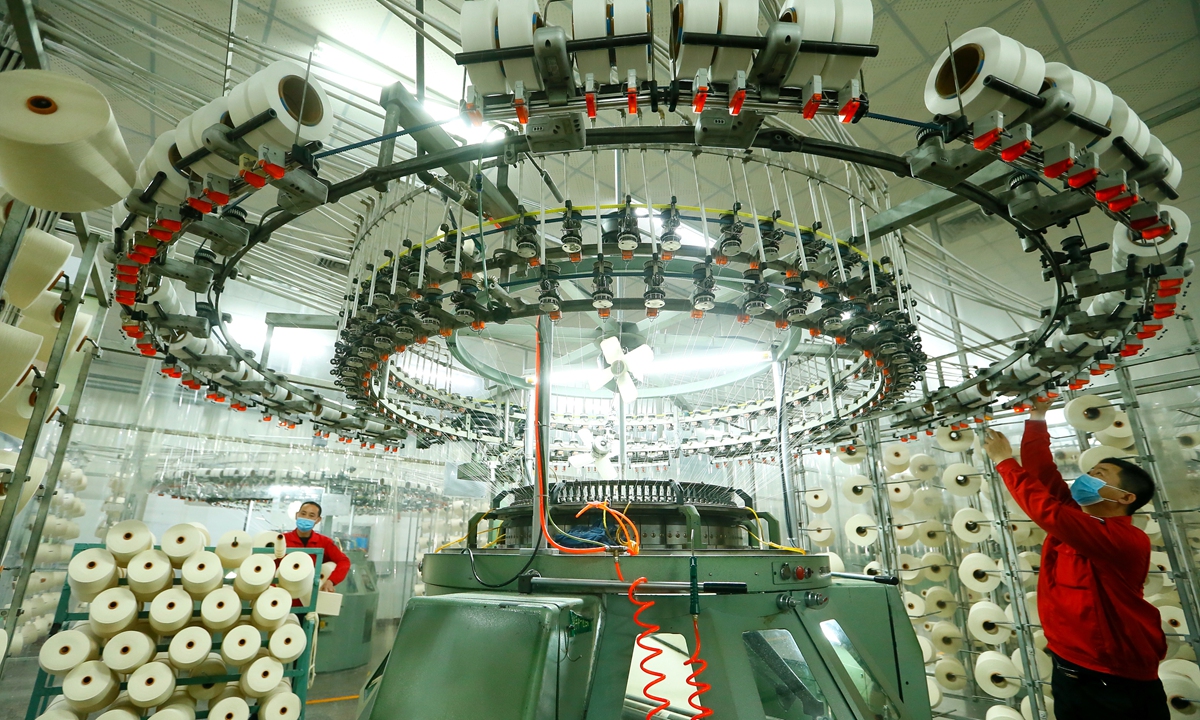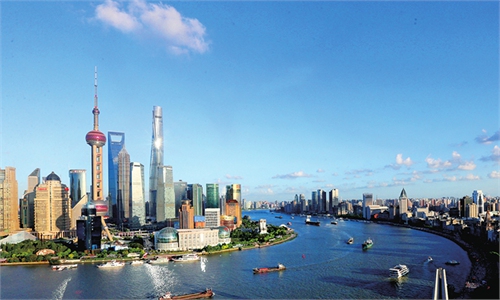Government meeting on stabilizing economy lifts market sentiment, with experts feeling upbeat about GDP rebound after COVID wanes

Workers produce fabric at a factory in the Jimo district in Qingdao, East China's Shandong Province on March 22, 2022. Firms in the district are rushing to fill export orders and meet foreign demand while strictly complying with anti-epidemic measures. Photo: cnsphoto
Soon after China convened what has been seen as an unprecedented national video teleconference on stabilizing the economy, entities ranging from central departments to local governments spared no time to map out their economy-lifting missions, while the stock market also edged up after investors received a message of determination from the government to guide the economy back to normal after a marked slowdown.
The instant reaction also mirrors the market's eagerness for a clear policy from the top to stimulate economic growth, as many businesspeople still feel a sense of uncertainty for future prospects after they encountered headwinds like coronavirus lockdowns and the Ukraine crisis, experts said.
At the teleconference held by China's State Council on Wednesday and reportedly included around 100,000 participants, Chinese Premier Li Keqiang stressed that the country must "grasp a time win-dow" and strive to get the economy back to normal.
The premier stressed that stabilizing growth needs to be given a higher priority as the country focuses on ensuring market entities, employment and people's livelihood.
Experts interpreted the meeting as marking a top-down resolution in safeguarding the momentum of the world's second-largest economy, while presenting a unified spirit will help the country overcome the headwinds.
"It's better early than late to map out economic work, in case the recent kind of black swan events hap-pen again in China," said Ye Qing, former deputy head of the Hubei Provincial Statistics Bureau, adding that one major objective of the recent arrangement is to achieve positive GDP growth in the second quarter.
Market response
Along with the meeting, different entities ranging from central departments to local governments have moved to align economic-lifting work in accordance with what has been instructed in the aforementioned meeting.
The People's Bank of China, China's central bank, issued a notice saying that it will push for the establishment of a long-term mechanism that makes financial institutions capable of and willing to lend loans to micro enterprises, the bank said on Thursday.
The State-Owned Assets Supervision and Administration Commission issued 27 measures to help alleviate small companies' difficulties, including reducing web fees for small enterprises.
China also launched 13 measures to support the trade sector including safeguarding production stability and increasing fiscal support to trade firms, according to a document published by the general office of the State Council, the Xinhua News Agency reported.
Local governments also took instant action. The Nanjing city government convened a meeting on Wednesday to study the allocation of work for stimulating the city's economy. The city's officials were requested to make clear work responsibilities and make efforts to achieve targets for the first half of this year.
China's stock markets edged up on Thursday, with the Shanghai Composite Index rising 0.5 percent, while the Shenzhen market rose 0.57 percent.
Several companies interviewed by the Global Times applauded the government's action to help domestic companies cope with difficulties, saying they still have confidence in a business rebound soon in spite of a business contraction recently.
A manager of a logistics company based in Shanghai surnamed Zhao told the Global Times on Thursday that the company's business has dropped by at least 50 percent in April due to the lockdown, but he expects the company's revenue to pick up by about 10 percent in May compared with the previous month as the city gradually lifts closed-loop management. His company engages in foreign trade.
According to Zhao, the growing complexity of the external environment including the US' Indo-Pacific strategy, high inflation abroad and the rising interest rate of the dollar, is casting a shadow of uncer-tainty on foreign trade companies. But he still holds confidence and believes that the epidemic will be brought under control soon.
"It would take another 2-3 months or more for the industry to recover to pre-epidemic level," Zhao said.
Liu Hongyuan, CEO of a compression socks maker and exporter Hangzhou Zhongzhi Industry Co., told the Global Times that he feels a mix of uncertainty and confidence in the future.
"I have confidence in the long-term development prospects of the sports industry (which boosts de-mands for our products), but our business pressure is heavy currently," he said.
This feeling of uncertainty has arisen from diminishing purchasing power or willingness from overseas clients, he said, which caused the company's exports to drop compared to last year.
He said that the company has benefited from the government's VAT credit refund policy, and he hopes more such support from the authorities, like favorable policies on loans to medium and small companies.
Future outlook
Although China is going through tremendous economic pressure, many economists are still upbeat about a rebound soon, as they pointed out that the fundamentals of China's economy have not been damaged by the recent difficulties.
Cong Yi, a professor at the Tianjin University of Finance and Economics, told the Global Times on Thursday that the current downward pressure is due to the sudden outbreak of the Omicron virus, rather than any fundamental problems.
"Our confidence and efforts to maintain growth comes from stable fundamentals-backed by China's huge market, strong production capability and domestic demand. Those will not disappear because of the temporary coronavirus resurgence," Cong said.
Cao Heping, an economist at Peking University, also told the Global Times on Thursday that if Shanghai can gradually recover by the end of May and seize the June window, China's economic growth can remain positive in the second quarter.
He said that in order to stabilize growth and market entities, stimulus ranging from tax cuts to other support measures have to be "extremely efficient," "quite precise" and go to those who need them most.
A report of the Economic Daily published on Thursday noted that China should not only face up to the current pressure, but should also recognize the internal economic rules in the long term, pointing out that China's economy is full of potential and resilience.
Experts also stressed that the government is looking to prepare for an "accurate" stimulus policy in the second quarter by mapping out and studying China's economic indicators.
Premier Li noted that major economic indicators for the second quarter across different parts of the country would be published by national statistics departments in a truthful manner.
"The government is attaching great importance to second quarter GDP data, being stricter about its calculations and hoping the numbers reflect China's genuine economic situation," Ye said.
Huo Jianguo, vice chairman of the China Society for World Trade Organization Studies in Beijing, told the Global Times on Thursday that there's no need to adjust the full-year growth target of 5.5 percent, although it means challenges for the third and fourth quarter's economic performance.

